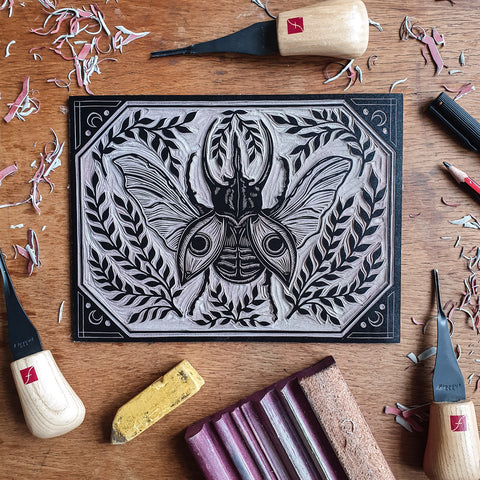There is a huge range of carving tools available for linocut. The price range and quality of tools varies massively, so it’s good to research the different kinds that are available. The carving side of lino printing is arguably the most enjoyable and can be quite meditative. That being said it can also become extremely frustrating when you are struggling to carve because of blunt tools. No matter how much you spend on linocut tools, it is essential that they are kept sharp. A blunt tool can completely ruin your carving and often discourage beginners from pursuing linocut any further. Make sure if you are purchasing a set of tools that you know how to correctly sharpen them to maximize their potential.

Types of tools
Often if you buy a kit or pack of tools you are given a full range of shapes of gouges, chisels and knives. What you may find is that for your style of linocut you may only use one or two of these tools religiously and the others just sit there looking pretty. It can work out cheaper to buy a full kit, but you can effectively create a block print with just a couple of tools. The most commonly used tools for block print are the V shape and U shape gouges. Both create different types of lines and can be used to produce a beautiful range of textures.

V Gouge – A V gouge is an incredibly versatile tool. It can make varying lines depending on how much pressure is applied. The width of the line can be widened by carving deeper into the lino. It can be used for extremely fine detail or can be used to create expressive textured strokes.

U Gouge- A U gouge is great if you want to carve something with a constant width. It can be used to create graphic marks with a rounded edge. The very fine U gouges are fantastic if you want to carve very neat lines around shapes, which is perfect for very intricate illustrative work. The larger U-Shaped tools are the best for quickly clearing away the larger areas of lino or can even create interesting stippled effects.

You can also get flatter U-shaped Gouges that can be used to soften harsh lines.
Knife – the knife (or hangito) tool can be used to cut away fine detail or even etch into the lino. This can be useful when wanting to create tiny details for example carving fur on an animal.

DIY Tool Kit
If you don't feel it's necessary to buy a full kit of tools, then just purchase a couple of essentials and keep adding to your collection as and when. A beginner’s kit would be an extra small and medium V shaped tool, a small and large U-shaped tool and a knife. These pretty much cover all the types of carving you will need. This configuration of tools might not be the same for everyone but it’s a good basis to work from.
Japanese Tools
These are great economic tools for beginners wanting to up their carving skill without spending too much. They are designed for wood but can be used on lino and can be sharpened with a slip strop or a whetstone. The handles are generally made from wood and are straight in shape aside from the “powergrip” range which are more curved. Some Japanese handles can be separated by removing the brass collar, and the gouge length can be adjusted to suit your preference.
Flexcut tools

Flexcut tools are an American brand of professional gouges which are relatively new to the printmaking world as they were originally manufactured for bushcraft. They can be used on wood or lino and are sharpened using a flexcut slipstrop. (more on this on page-) You can purchase both long and straight handle tools or the palm shaped handles depending on your grip preference. Flexcut tools can be bought individually or as “micro palm set” or “mini palm set” These sets give you a range of small U Shape and V shape gouges and will cover most of your carving needs.
Pfeil Tools
Pfeil are Swiss tools made from specially alloyed, hard tool steel. They have a bulbous shaped wooden handle made from Ash that sits in the palm of your hand. The professional quality and durability mean they are highly popular with printmakers, as there is a huge variety of tools you can purchase with a wide range of gouge shapes and sizes. The tools can be bought individually or as a set of 6, 8 or 12. If you are just starting out you may not want to buy a larger set as you probably won't end up using all of them so a set of 6 tools is a good starting point and you can always add more to your collection later on.

Pfeils sizing cart is very detailed but can be a little confusing if you haven’t bought their tools before. Essentially the “L” range is most preferable for lino or woodcut and the number before the slash indicates the curvature or sweep of the gouges. Numbers 11 and under indicate a U shape. The lower the number the flatter the U. Numbers 12 and above indicate a V shape. The numbers after the slash show the size of the gouge. Therefore, a L 12/1 gouge would be an extra small V gouge.

